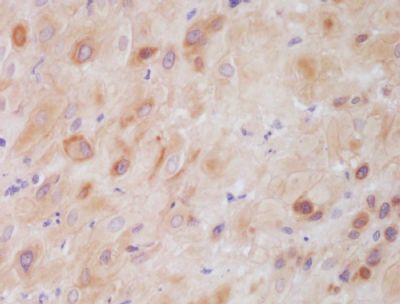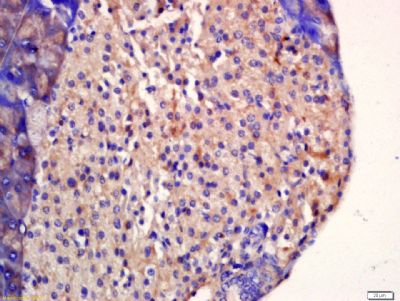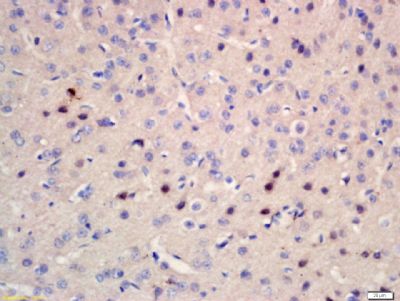产品中心
当前位置:首页>产品中心Anti-CSP
货号: bs-12944R 基本售价: 1380.0 元 规格: 100ul
- 规格:100ul
- 价格:1380.00元
- 规格:200ul
- 价格:2200.00元
产品信息
- 产品编号
- bs-12944R
- 英文名称
- CSP
- 中文名称
- 半胱氨酸延伸蛋白α抗体
- 别 名
- CLN 4; CLN4; CLN4B; CSP; cysteine string protein alpha; Cysteine string protein; DJC5; DnaJ (Hsp40) homolog subfamily C member 5; DnaJ homolog subfamily C member 5; DNAJC 5; Dnajc5; DNAJC5A; DNJC5_HUMAN; NCL.
- 规格价格
- 100ul/1380元购买 200ul/2200元购买 大包装/询价
- 说 明 书
- 100ul 200ul
- 研究领域
- 细胞生物 神经生物学 信号转导 细胞类型标志物
- 抗体来源
- Rabbit
- 克隆类型
- Polyclonal
- 交叉反应
- Human, Mouse, Rat, Pig, Cow, Horse, Rabbit, Sheep, Guinea Pig,
- 产品应用
- WB=1:500-2000 ELISA=1:500-1000 IHC-P=1:400-800 IHC-F=1:400-800 ICC=1:100-500 IF=1:100-500 (石蜡切片需做抗原修复)
not yet tested in other applications.
optimal dilutions/concentrations should be determined by the end user.
- 分 子 量
- 22kDa
- 细胞定位
- 细胞膜
- 性 状
- Lyophilized or Liquid
- 浓 度
- 1mg/ml
- 免 疫 原
- KLH conjugated synthetic peptide derived from human CSP:1-100/198
- 亚 型
- IgG
- 纯化方法
- affinity purified by Protein A
- 储 存 液
- 0.01M TBS(pH7.4) with 1% BSA, 0.03% Proclin300 and 50% Glycerol.
- 保存条件
- Store at -20 °C for one year. Avoid repeated freeze/thaw cycles. The lyophilized antibody is stable at room temperature for at least one month and for greater than a year when kept at -20°C. When reconstituted in sterile pH 7.4 0.01M PBS or diluent of antibody the antibody is stable for at least two weeks at 2-4 °C.
- PubMed
- PubMed
- 产品介绍
- background:
Cysteine string proteins (CSPs) are synaptic vesicle-associated, secretory vesicle proteins that are involved in Ca2+-regulated exocytosis of synaptic vesicles and modulation of presynaptic transmembrane calcium fluxes in neuroendocrine and endocrine cell types. CSP contains a J-domain that binds HSP 70/HSC 70 chaperone ATPases and a membrane-targeting, palmitoylated cysteine-rich string region. CSPs may act as molecular chaperones in synapses, and mediate conformational folding of components of the vesicular exocytotic machinery. CSP is involved in the fine tuning of neurotransmission through its interaction with receptor-coupled trimeric GTP binding proteins (G proteins) and N-type Ca2+ channels. Two variants of CSP have been described: CSP1; and the 31 amino acid, C-terminally truncated isoform, CSP2. Subcellular fractionation of insulinoma cells shows CSP1 in granular fractions, while the membrane and cytosol fractions contain predominantly CSP2. The fractions also contain additional proteins, presumably CSP dimers. Furthermore, in various mammalian cell lines (including rat brain) CSP1 expression predominates CSP2 expression.
Function:
May have an important role in presynaptic function. May be involved in calcium-dependent neurotransmitter release at nerve endings.
Subunit:
Homodimer (Probable). Interacts with the chaperone complex consisting of HSC70 and SGTA (By similarity).
Subcellular Location:
Membrane. Melanosome. Identified by mass spectrometry in melanosome fractions from stage I to stage IV.
Tissue Specificity:
Expressed in pancreas, kidney, skeletal muscle, liver, lung, placenta, brain and heart.
Post-translational modifications:
Fatty acylated. Heavily palmitoylated in the cysteine string motif.
DISEASE:
Neuronal ceroid lipofuscinosis 4B (CLN4B) [MIM:162350]: An adult-onset neuronal ceroid lipofuscinosis. Neuronal ceroid lipofuscinoses are progressive neurodegenerative, lysosomal storage diseases characterized by intracellular accumulation of autofluorescent liposomal material, and clinically by seizures, dementia, visual loss, and/or cerebral atrophy. CLN4B has no visual involvement and is characterized by seizures and other neurologic symptoms. Note=The disease is caused by mutations affecting the gene represented in this entry.
Similarity:
Contains 1 J domain.
SWISS:
Q9H3Z4
Gene ID:
80331
Database links:Entrez Gene: 80331 Human
Entrez Gene: 13002 Mouse
Entrez Gene: 79130 Rat
Omim: 611203 Human
SwissProt: Q9H3Z4 Human
SwissProt: P60904 Mouse
SwissProt: P60905 Rat
Unigene: 164419 Human
Unigene: 140761 Mouse
Unigene: 391807 Mouse
Unigene: 100120 Rat
Important Note:
This product as supplied is intended for research use only, not for use in human, therapeutic or diagnostic applications.
- 产品图片
 Tissue/cell: human placenta tissue; 4% Paraformaldehyde-fixed and paraffin-embedded;
Tissue/cell: human placenta tissue; 4% Paraformaldehyde-fixed and paraffin-embedded;
Antigen retrieval: citrate buffer ( 0.01M, pH 6.0 ), Boiling bathing for 15min; Block endogenous peroxidase by 3% Hydrogen peroxide for 30min; Blocking buffer (normal goat serum,C-0005) at 37℃ for 20 min;
Incubation: Anti-CSP Polyclonal Antibody, Unconjugated(bs-12944R) 1:200, overnight at 4°C, followed by conjugation to the secondary antibody(SP-0023) and DAB(C-0010) staining Tissue/cell: Rat pancreas tissue; 4% Paraformaldehyde-fixed and paraffin-embedded;
Tissue/cell: Rat pancreas tissue; 4% Paraformaldehyde-fixed and paraffin-embedded;
Antigen retrieval: citrate buffer ( 0.01M, pH 6.0 ), Boiling bathing for 15min; Block endogenous peroxidase by 3% Hydrogen peroxide for 30min; Blocking buffer (normal goat serum,C-0005) at 37℃ for 20 min;
Incubation: Anti-CSP Polyclonal Antibody, Unconjugated(bs-12944R) 1:200, overnight at 4°C, followed by conjugation to the secondary antibody(SP-0023) and DAB(C-0010) staining Tissue/cell: rat brain tissue; 4% Paraformaldehyde-fixed and paraffin-embedded;
Tissue/cell: rat brain tissue; 4% Paraformaldehyde-fixed and paraffin-embedded;
Antigen retrieval: citrate buffer ( 0.01M, pH 6.0 ), Boiling bathing for 15min; Block endogenous peroxidase by 3% Hydrogen peroxide for 30min; Blocking buffer (normal goat serum,C-0005) at 37℃ for 20 min;
Incubation: Anti-CSP Polyclonal Antibody, Unconjugated(bs-12944R) 1:200, overnight at 4°C, followed by conjugation to the secondary antibody(SP-0023) and DAB(C-0010) staining

